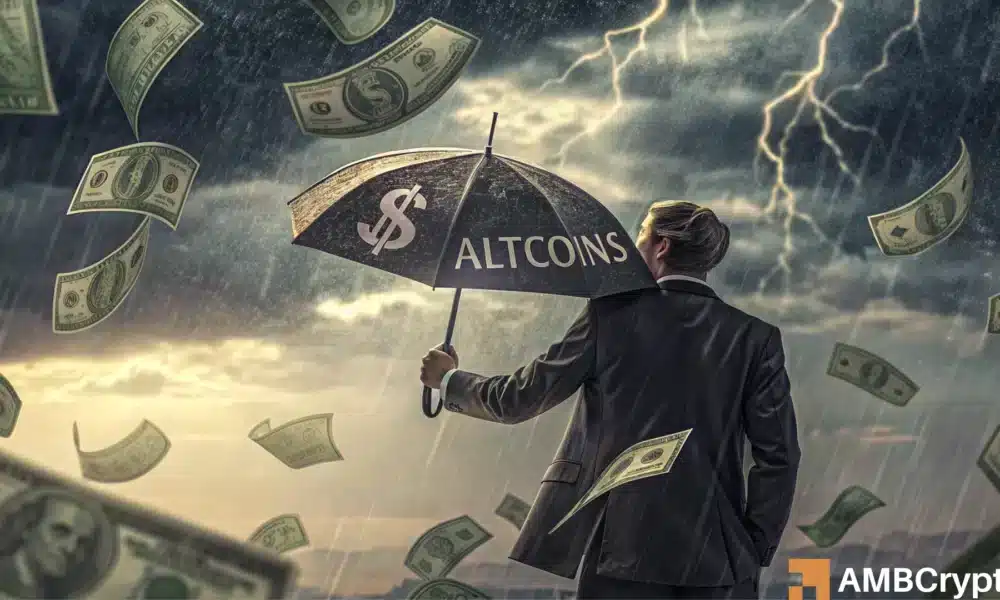Title: Understanding the Current Altcoin Market Dynamics: An Overview of Altseason Fluctuations
The cryptocurrency market is characterized by its volatility and rapid fluctuations, where certain trends emerge, only to be tested by underlying market forces. Recently, the Altcoin Open Interest (OI) surged to an impressive $61.7 billion, while the Altcoin Season Index reached a notable 61—its first significant test since early 2025. However, despite these milestones, there is a palpable sense of uncertainty surrounding the sustainability of this rally. Fading rotational flows have stoked doubts about whether we are indeed witnessing a genuine altseason or merely a fleeting moment in a broader BTC-led cycle.
In a striking development, the cryptocurrency market experienced a sudden downturn, shedding approximately $20 billion in just under 72 hours. Bitcoin (BTC) made up a significant portion of this loss, seeing its value drop by about $10 billion. This downturn underscores that the current cycle remains heavily influenced by BTC trends, as indicated by its dominance in the market, which recently slipped to multi-month lows of 57%. Correspondingly, TOTAL2, which represents the market cap of cryptocurrencies excluding BTC, also declined, revealing a risk-off sentiment among investors as rotational flows hesitated.
Interestingly, despite the overall market contraction, Altcoin Futures Open Interest witnessed a remarkable spike of $9.2 billion on August 22, pushing total altcoin OI to an all-time high of $61.7 billion. This juxtaposition highlights a growing leverage interest in altcoins amid a backdrop of uncertain market flows. Typically, spikes in Open Interest align with Bitcoin’s price movements, but during this period, we observed the leading altcoin OI steadily climbing from $20 billion in March to approximately $60 billion by late August—a significant increase of nearly $40 billion. In contrast, Bitcoin’s OI only grew by around $30 billion in the same timeframe. Such a disparity raises concerns about potential overexposure in the altcoin market, as traders scamper to capitalize on what they perceive as an impending altseason. However, muted rotational flows might lead to a cycle of heightened volatility instead.
The breakout of the Altcoin Index offers a double-edged sword; while it suggests growth, the high leverage across altcoins—especially following recent market corrections—could amplify any downturns. For instance, Ethereum (ETH), representing one of the leading altcoins, experienced a nearly 4% drop in OI over a 24-hour period, aligning closely with a 3% price decline. In comparison, Bitcoin managed to limit its drop to just 2.68%. This pattern illustrates a concerning dynamic where altcoins face more significant fluctuations, particularly after being buoyed by Bitcoin’s corrections, which appear to have an increasingly pronounced impact.
Historical context serves as a cautionary tale in this instance. A similar market setup observed in late January to early February provides critical insights; the Altcoin Season Index peaked at 61, yet a subsequent 18% decline in Bitcoin ultimately left the index plummeting to 20 by the conclusion of Q1. Ethereum saw precipitous drops, hitting a monthly low of $1,440, which translated into similar declines for other altcoins. The recurring theme underscores a vulnerability within the altcoin market, raising the question of whether the current conditions truly set the stage for an extended altseason or if we are witnessing precursors to another downturn.
In conclusion, while the altcoin market is currently experiencing heightened interest and high leverage, it remains susceptible to broader market influences, particularly from Bitcoin. Investors and traders must navigate these complex conditions with caution, as the current signals suggest that without a significant increase in rotational flows, any rebound for altcoins may be temporary. The altcoin market’s vulnerabilities are clear, emphasizing the importance of ongoing analysis and awareness as we explore the evolving landscape of cryptocurrency investments. As traders look toward the future, the critical question remains: Can altcoins sustain their momentum, or are they destined for another round of corrections?


